BUSN20017 Essay: Overcoming Intercultural Communication Barriers
VerifiedAdded on 2023/03/30
|9
|2031
|382
Essay
AI Summary
This essay, written for the BUSN20017 course, investigates the common barriers to intercultural communication in the workplace and proposes strategies for overcoming them. It highlights the importance of effective communication in a diverse work environment, where employees from various cultural backgrounds interact. The essay delves into factors like preconceived ideas, comfort zones, and fear of judgment as obstacles to communication. It suggests solutions based on the expectancy theory, emphasizing appreciation and rewards for positive communication, alongside the potential use of penalties to ensure information sharing. Furthermore, the essay recommends gathering employee feedback through questionnaires to identify specific communication challenges within the organization. It concludes by emphasizing the need for companies to tailor their approaches based on their unique philosophies and communication barriers, providing a framework for future research and management practices in fostering a more inclusive and communicative workplace. The research also suggests the importance of encouraging employees to communicate, regardless of cultural differences, and to take feedback from the employees themselves to get to the root of the problem.
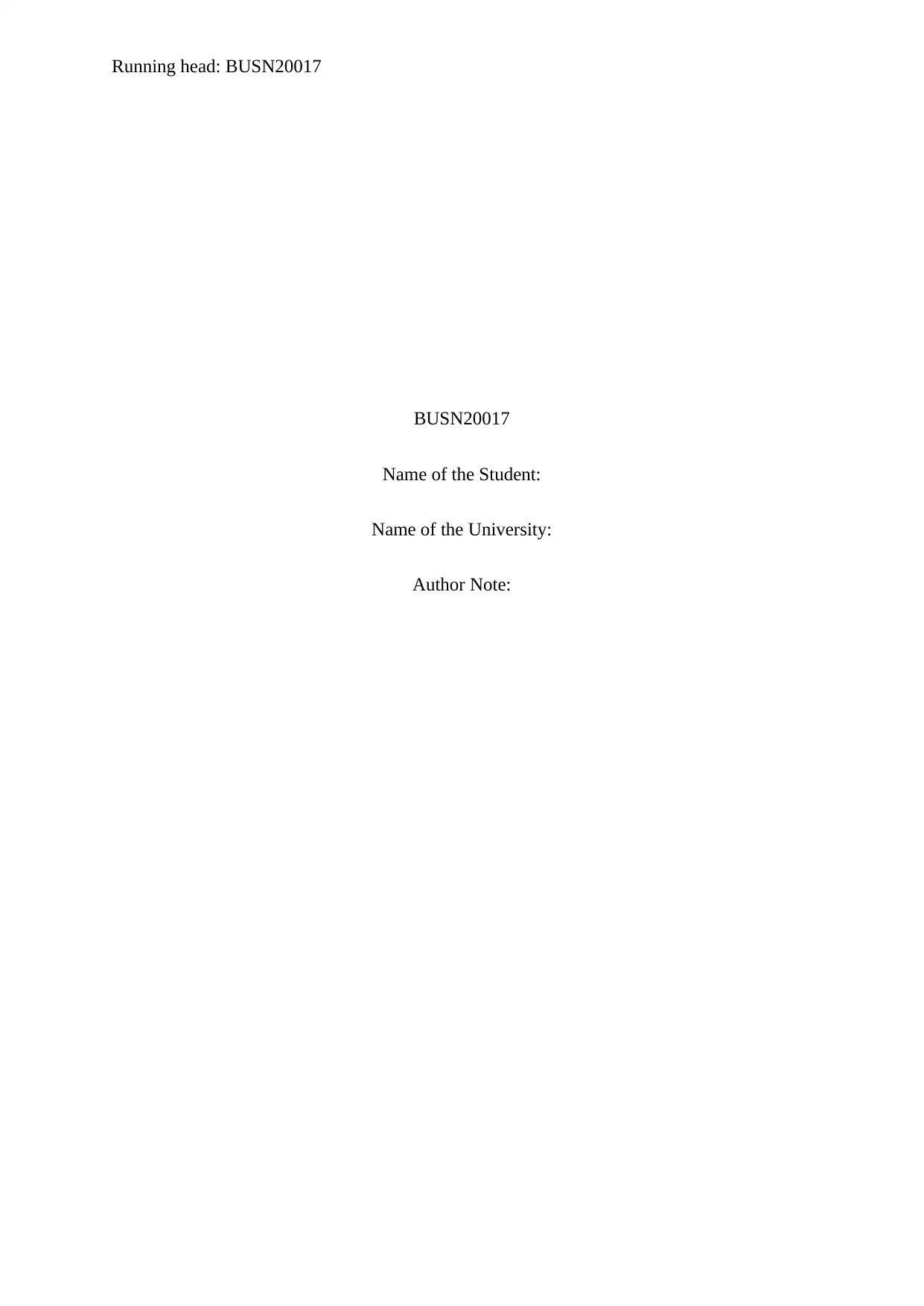
Running head: BUSN20017
BUSN20017
Name of the Student:
Name of the University:
Author Note:
BUSN20017
Name of the Student:
Name of the University:
Author Note:
Paraphrase This Document
Need a fresh take? Get an instant paraphrase of this document with our AI Paraphraser

1BUSN20017
HOW CAN BARRIERS TO INTERCULTURAL COMMUNICATION BE
OVERCOME IN THE WORKPLACE?
The research topic, which this article adheres to, is to find out what barriers most
commonly exist in the field of intercultural communication in the workplace. Intercultural
communication refers to the communication process between two more individuals, hailing
from different cultural backgrounds. According to Oliphant (2019), the point of interaction or
touchpoints between these individuals can be manipulated by a set of beliefs or stigma that
exist within the individuals. This can further lead to a noise factor, thereby disrupting the
interpretation of the communication process or the entire communication process altogether.
Communication in the workplace is integral to the success of a company. This is because the
majority of the people, who work in a company, do not necessarily belong to a similar
cultural background. This is essentially because companies usually hire people based on their
potential and expertise and not based on their cultural backgrounds. Without communication,
the firm is bound to falter towards achieving its goals. Forster (2019) says that this is because
information flow is not linear in nature at all times, and without the use of a proper
communication process across all the departments, the coordination within the workplace will
be disrupted, causing mass confusion in the workplace, and hence, a failure for the company.
This is why it must be noted that communication aids in coordination, and helps a firm to
move smoothly along its path towards its goals. This is why intercultural communication in
the workplace is a process that is bound to arise at some point, and barriers to this process
must be eliminated in order for a company to succeed. This is the reason why many
companies have paid particular focus on this matter in the recent times, such as The Coca-
Cola Company (Hammonds & Perry, 2016).
The question, which this research essay will be attempting at answering, is how can
firms overcome the common barriers to intercultural communication in the workplace. It is a
HOW CAN BARRIERS TO INTERCULTURAL COMMUNICATION BE
OVERCOME IN THE WORKPLACE?
The research topic, which this article adheres to, is to find out what barriers most
commonly exist in the field of intercultural communication in the workplace. Intercultural
communication refers to the communication process between two more individuals, hailing
from different cultural backgrounds. According to Oliphant (2019), the point of interaction or
touchpoints between these individuals can be manipulated by a set of beliefs or stigma that
exist within the individuals. This can further lead to a noise factor, thereby disrupting the
interpretation of the communication process or the entire communication process altogether.
Communication in the workplace is integral to the success of a company. This is because the
majority of the people, who work in a company, do not necessarily belong to a similar
cultural background. This is essentially because companies usually hire people based on their
potential and expertise and not based on their cultural backgrounds. Without communication,
the firm is bound to falter towards achieving its goals. Forster (2019) says that this is because
information flow is not linear in nature at all times, and without the use of a proper
communication process across all the departments, the coordination within the workplace will
be disrupted, causing mass confusion in the workplace, and hence, a failure for the company.
This is why it must be noted that communication aids in coordination, and helps a firm to
move smoothly along its path towards its goals. This is why intercultural communication in
the workplace is a process that is bound to arise at some point, and barriers to this process
must be eliminated in order for a company to succeed. This is the reason why many
companies have paid particular focus on this matter in the recent times, such as The Coca-
Cola Company (Hammonds & Perry, 2016).
The question, which this research essay will be attempting at answering, is how can
firms overcome the common barriers to intercultural communication in the workplace. It is a
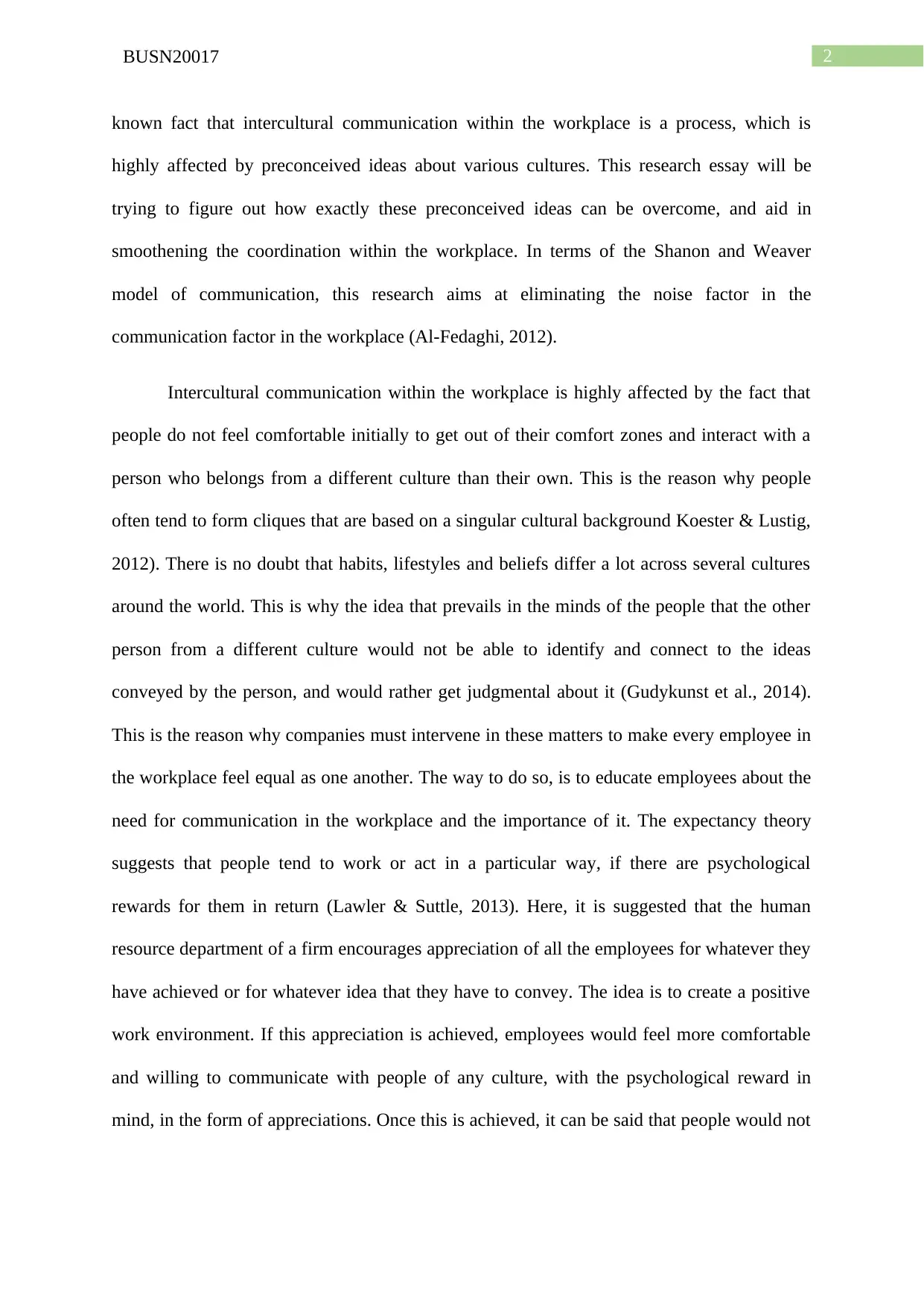
2BUSN20017
known fact that intercultural communication within the workplace is a process, which is
highly affected by preconceived ideas about various cultures. This research essay will be
trying to figure out how exactly these preconceived ideas can be overcome, and aid in
smoothening the coordination within the workplace. In terms of the Shanon and Weaver
model of communication, this research aims at eliminating the noise factor in the
communication factor in the workplace (Al-Fedaghi, 2012).
Intercultural communication within the workplace is highly affected by the fact that
people do not feel comfortable initially to get out of their comfort zones and interact with a
person who belongs from a different culture than their own. This is the reason why people
often tend to form cliques that are based on a singular cultural background Koester & Lustig,
2012). There is no doubt that habits, lifestyles and beliefs differ a lot across several cultures
around the world. This is why the idea that prevails in the minds of the people that the other
person from a different culture would not be able to identify and connect to the ideas
conveyed by the person, and would rather get judgmental about it (Gudykunst et al., 2014).
This is the reason why companies must intervene in these matters to make every employee in
the workplace feel equal as one another. The way to do so, is to educate employees about the
need for communication in the workplace and the importance of it. The expectancy theory
suggests that people tend to work or act in a particular way, if there are psychological
rewards for them in return (Lawler & Suttle, 2013). Here, it is suggested that the human
resource department of a firm encourages appreciation of all the employees for whatever they
have achieved or for whatever idea that they have to convey. The idea is to create a positive
work environment. If this appreciation is achieved, employees would feel more comfortable
and willing to communicate with people of any culture, with the psychological reward in
mind, in the form of appreciations. Once this is achieved, it can be said that people would not
known fact that intercultural communication within the workplace is a process, which is
highly affected by preconceived ideas about various cultures. This research essay will be
trying to figure out how exactly these preconceived ideas can be overcome, and aid in
smoothening the coordination within the workplace. In terms of the Shanon and Weaver
model of communication, this research aims at eliminating the noise factor in the
communication factor in the workplace (Al-Fedaghi, 2012).
Intercultural communication within the workplace is highly affected by the fact that
people do not feel comfortable initially to get out of their comfort zones and interact with a
person who belongs from a different culture than their own. This is the reason why people
often tend to form cliques that are based on a singular cultural background Koester & Lustig,
2012). There is no doubt that habits, lifestyles and beliefs differ a lot across several cultures
around the world. This is why the idea that prevails in the minds of the people that the other
person from a different culture would not be able to identify and connect to the ideas
conveyed by the person, and would rather get judgmental about it (Gudykunst et al., 2014).
This is the reason why companies must intervene in these matters to make every employee in
the workplace feel equal as one another. The way to do so, is to educate employees about the
need for communication in the workplace and the importance of it. The expectancy theory
suggests that people tend to work or act in a particular way, if there are psychological
rewards for them in return (Lawler & Suttle, 2013). Here, it is suggested that the human
resource department of a firm encourages appreciation of all the employees for whatever they
have achieved or for whatever idea that they have to convey. The idea is to create a positive
work environment. If this appreciation is achieved, employees would feel more comfortable
and willing to communicate with people of any culture, with the psychological reward in
mind, in the form of appreciations. Once this is achieved, it can be said that people would not
⊘ This is a preview!⊘
Do you want full access?
Subscribe today to unlock all pages.

Trusted by 1+ million students worldwide

3BUSN20017
feel the fear of being judged for their ideas after one point, and it can lay the foundation for
increased coordination within the workplace in the near future.
Another point is exactly the opposite to the previous point. It suggests that people also
act in a certain manner, when they fear a negative outcome if they do not do so, as per
Delgado et al. (2019). In this context, it is advised that companies establish the importance of
intercultural communication within the workplace, besides holding any employee responsible
if it is found that a coordination process has been hampered or disrupted because of lack of
information flow on their part. These employees can be penalized accordingly. Once this fear
of penalization is accomplished, employees are bound to communicate at all costs, setting the
notions of cultural differences aside. This can benefit the company hugely due to the
improved communication process and the enhanced coordination across departments.
However, there is a bad side to it. It is proven and also widely believed that when people do
some things out of mere compulsion and without any motivation going behind it, mental
fatigue takes place (Gibson et al., 2013). This can only lead to accomplishment of short term
goals and bigger problems for the company in the future, such as employee turnover. This is
why fear must be accomplished besides encouragement. Employees must be encouraged to
talk to one another, regardless of the cultural differences that exist between them. To be
precise, to sum up the whole point of this paragraph, employees must be gathered around, and
told about the penalty factor that would follow them if they fail to communicate properly
within the workplace. Followed by that, they must be told why they should not be reluctant
towards intercultural communication, listing out the positive sides of it. they must be told
about the benefits of openness to experiences when someone interacts with someone of a
completely different culture, and how in the future they would have to lead a team of people
belonging to different cultural backgrounds. This would give employees a positive reason to
avoid the fear, thereby reducing the chances of mental fatigue.
feel the fear of being judged for their ideas after one point, and it can lay the foundation for
increased coordination within the workplace in the near future.
Another point is exactly the opposite to the previous point. It suggests that people also
act in a certain manner, when they fear a negative outcome if they do not do so, as per
Delgado et al. (2019). In this context, it is advised that companies establish the importance of
intercultural communication within the workplace, besides holding any employee responsible
if it is found that a coordination process has been hampered or disrupted because of lack of
information flow on their part. These employees can be penalized accordingly. Once this fear
of penalization is accomplished, employees are bound to communicate at all costs, setting the
notions of cultural differences aside. This can benefit the company hugely due to the
improved communication process and the enhanced coordination across departments.
However, there is a bad side to it. It is proven and also widely believed that when people do
some things out of mere compulsion and without any motivation going behind it, mental
fatigue takes place (Gibson et al., 2013). This can only lead to accomplishment of short term
goals and bigger problems for the company in the future, such as employee turnover. This is
why fear must be accomplished besides encouragement. Employees must be encouraged to
talk to one another, regardless of the cultural differences that exist between them. To be
precise, to sum up the whole point of this paragraph, employees must be gathered around, and
told about the penalty factor that would follow them if they fail to communicate properly
within the workplace. Followed by that, they must be told why they should not be reluctant
towards intercultural communication, listing out the positive sides of it. they must be told
about the benefits of openness to experiences when someone interacts with someone of a
completely different culture, and how in the future they would have to lead a team of people
belonging to different cultural backgrounds. This would give employees a positive reason to
avoid the fear, thereby reducing the chances of mental fatigue.
Paraphrase This Document
Need a fresh take? Get an instant paraphrase of this document with our AI Paraphraser
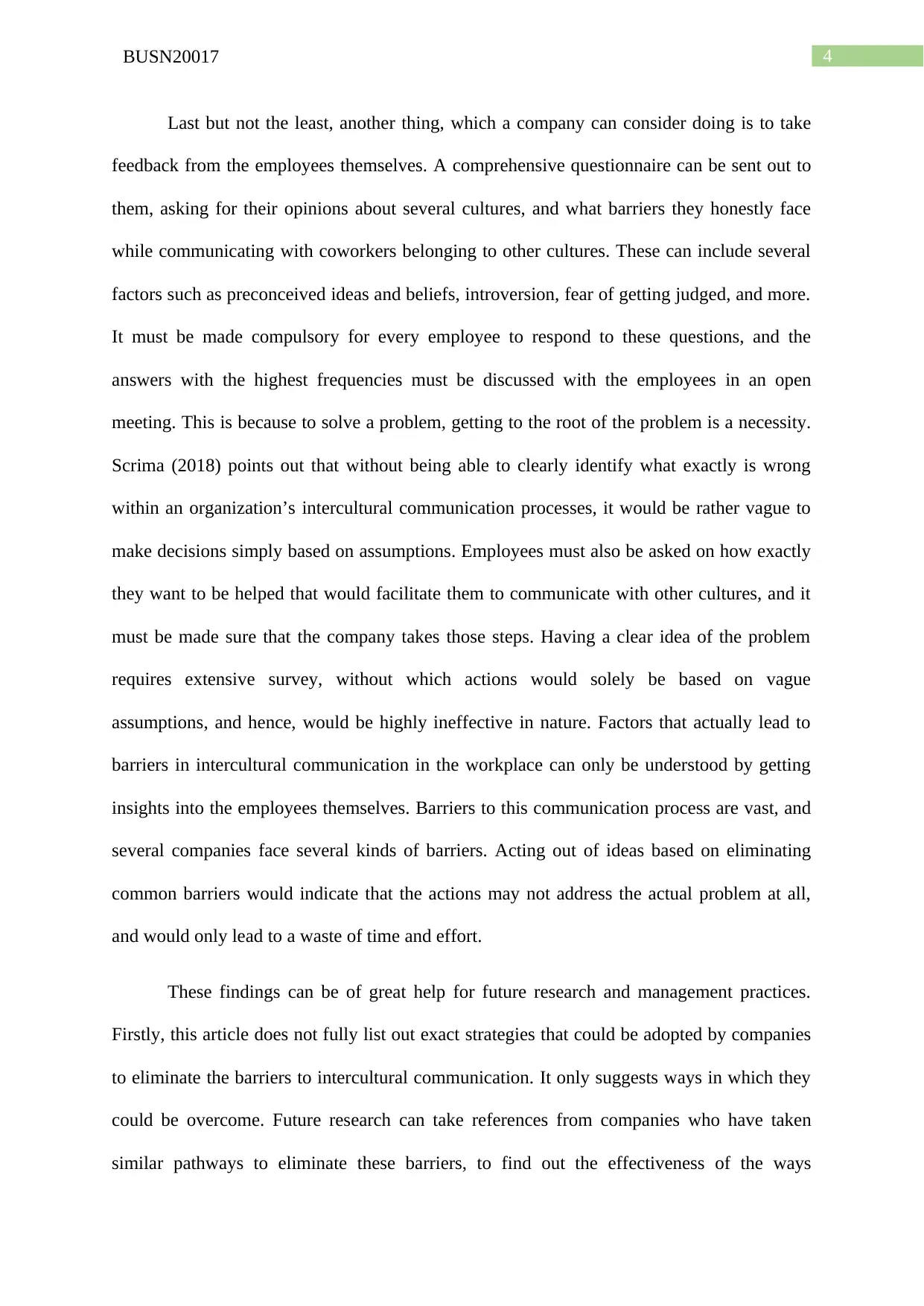
4BUSN20017
Last but not the least, another thing, which a company can consider doing is to take
feedback from the employees themselves. A comprehensive questionnaire can be sent out to
them, asking for their opinions about several cultures, and what barriers they honestly face
while communicating with coworkers belonging to other cultures. These can include several
factors such as preconceived ideas and beliefs, introversion, fear of getting judged, and more.
It must be made compulsory for every employee to respond to these questions, and the
answers with the highest frequencies must be discussed with the employees in an open
meeting. This is because to solve a problem, getting to the root of the problem is a necessity.
Scrima (2018) points out that without being able to clearly identify what exactly is wrong
within an organization’s intercultural communication processes, it would be rather vague to
make decisions simply based on assumptions. Employees must also be asked on how exactly
they want to be helped that would facilitate them to communicate with other cultures, and it
must be made sure that the company takes those steps. Having a clear idea of the problem
requires extensive survey, without which actions would solely be based on vague
assumptions, and hence, would be highly ineffective in nature. Factors that actually lead to
barriers in intercultural communication in the workplace can only be understood by getting
insights into the employees themselves. Barriers to this communication process are vast, and
several companies face several kinds of barriers. Acting out of ideas based on eliminating
common barriers would indicate that the actions may not address the actual problem at all,
and would only lead to a waste of time and effort.
These findings can be of great help for future research and management practices.
Firstly, this article does not fully list out exact strategies that could be adopted by companies
to eliminate the barriers to intercultural communication. It only suggests ways in which they
could be overcome. Future research can take references from companies who have taken
similar pathways to eliminate these barriers, to find out the effectiveness of the ways
Last but not the least, another thing, which a company can consider doing is to take
feedback from the employees themselves. A comprehensive questionnaire can be sent out to
them, asking for their opinions about several cultures, and what barriers they honestly face
while communicating with coworkers belonging to other cultures. These can include several
factors such as preconceived ideas and beliefs, introversion, fear of getting judged, and more.
It must be made compulsory for every employee to respond to these questions, and the
answers with the highest frequencies must be discussed with the employees in an open
meeting. This is because to solve a problem, getting to the root of the problem is a necessity.
Scrima (2018) points out that without being able to clearly identify what exactly is wrong
within an organization’s intercultural communication processes, it would be rather vague to
make decisions simply based on assumptions. Employees must also be asked on how exactly
they want to be helped that would facilitate them to communicate with other cultures, and it
must be made sure that the company takes those steps. Having a clear idea of the problem
requires extensive survey, without which actions would solely be based on vague
assumptions, and hence, would be highly ineffective in nature. Factors that actually lead to
barriers in intercultural communication in the workplace can only be understood by getting
insights into the employees themselves. Barriers to this communication process are vast, and
several companies face several kinds of barriers. Acting out of ideas based on eliminating
common barriers would indicate that the actions may not address the actual problem at all,
and would only lead to a waste of time and effort.
These findings can be of great help for future research and management practices.
Firstly, this article does not fully list out exact strategies that could be adopted by companies
to eliminate the barriers to intercultural communication. It only suggests ways in which they
could be overcome. Future research can take references from companies who have taken
similar pathways to eliminate these barriers, to find out the effectiveness of the ways
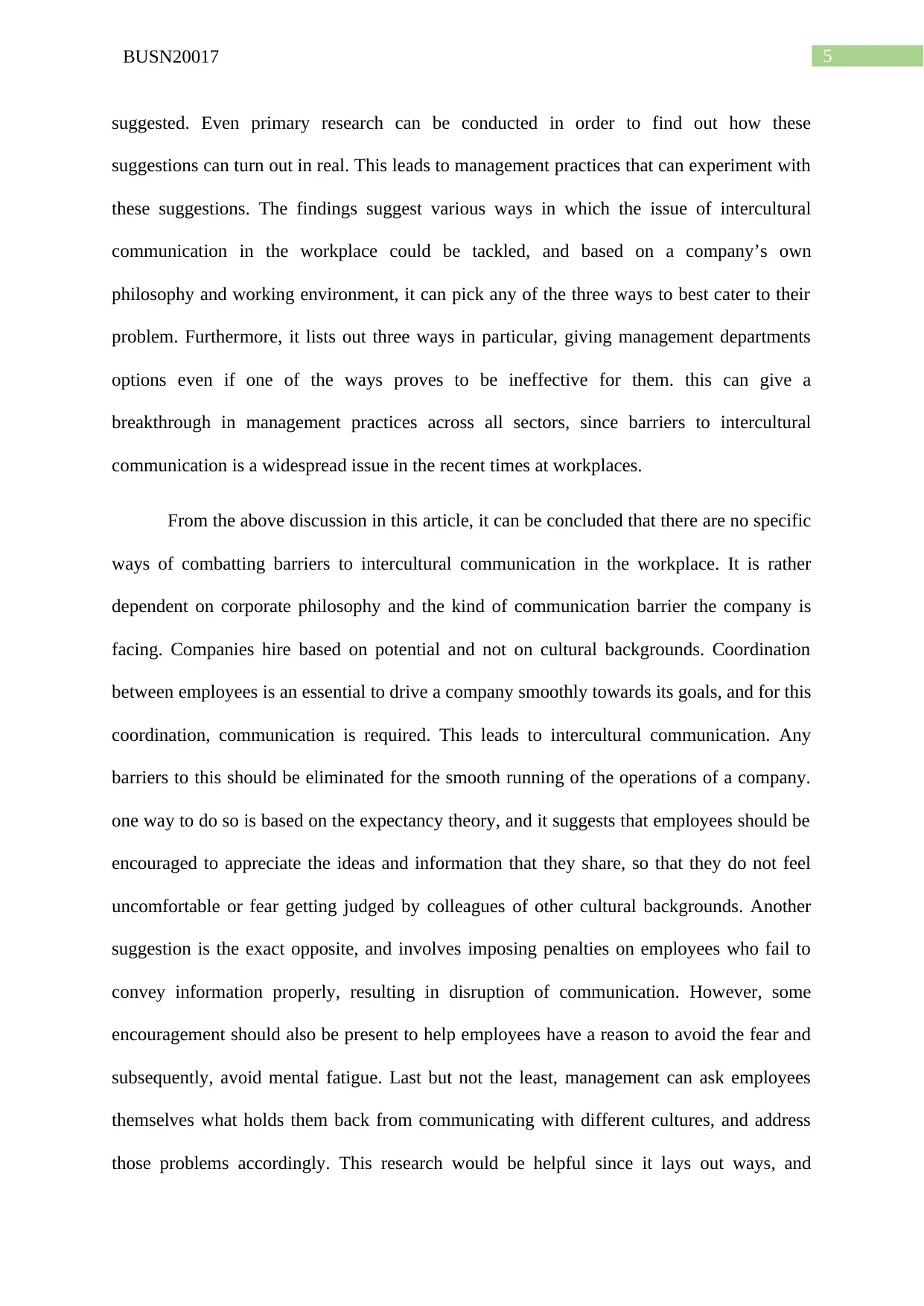
5BUSN20017
suggested. Even primary research can be conducted in order to find out how these
suggestions can turn out in real. This leads to management practices that can experiment with
these suggestions. The findings suggest various ways in which the issue of intercultural
communication in the workplace could be tackled, and based on a company’s own
philosophy and working environment, it can pick any of the three ways to best cater to their
problem. Furthermore, it lists out three ways in particular, giving management departments
options even if one of the ways proves to be ineffective for them. this can give a
breakthrough in management practices across all sectors, since barriers to intercultural
communication is a widespread issue in the recent times at workplaces.
From the above discussion in this article, it can be concluded that there are no specific
ways of combatting barriers to intercultural communication in the workplace. It is rather
dependent on corporate philosophy and the kind of communication barrier the company is
facing. Companies hire based on potential and not on cultural backgrounds. Coordination
between employees is an essential to drive a company smoothly towards its goals, and for this
coordination, communication is required. This leads to intercultural communication. Any
barriers to this should be eliminated for the smooth running of the operations of a company.
one way to do so is based on the expectancy theory, and it suggests that employees should be
encouraged to appreciate the ideas and information that they share, so that they do not feel
uncomfortable or fear getting judged by colleagues of other cultural backgrounds. Another
suggestion is the exact opposite, and involves imposing penalties on employees who fail to
convey information properly, resulting in disruption of communication. However, some
encouragement should also be present to help employees have a reason to avoid the fear and
subsequently, avoid mental fatigue. Last but not the least, management can ask employees
themselves what holds them back from communicating with different cultures, and address
those problems accordingly. This research would be helpful since it lays out ways, and
suggested. Even primary research can be conducted in order to find out how these
suggestions can turn out in real. This leads to management practices that can experiment with
these suggestions. The findings suggest various ways in which the issue of intercultural
communication in the workplace could be tackled, and based on a company’s own
philosophy and working environment, it can pick any of the three ways to best cater to their
problem. Furthermore, it lists out three ways in particular, giving management departments
options even if one of the ways proves to be ineffective for them. this can give a
breakthrough in management practices across all sectors, since barriers to intercultural
communication is a widespread issue in the recent times at workplaces.
From the above discussion in this article, it can be concluded that there are no specific
ways of combatting barriers to intercultural communication in the workplace. It is rather
dependent on corporate philosophy and the kind of communication barrier the company is
facing. Companies hire based on potential and not on cultural backgrounds. Coordination
between employees is an essential to drive a company smoothly towards its goals, and for this
coordination, communication is required. This leads to intercultural communication. Any
barriers to this should be eliminated for the smooth running of the operations of a company.
one way to do so is based on the expectancy theory, and it suggests that employees should be
encouraged to appreciate the ideas and information that they share, so that they do not feel
uncomfortable or fear getting judged by colleagues of other cultural backgrounds. Another
suggestion is the exact opposite, and involves imposing penalties on employees who fail to
convey information properly, resulting in disruption of communication. However, some
encouragement should also be present to help employees have a reason to avoid the fear and
subsequently, avoid mental fatigue. Last but not the least, management can ask employees
themselves what holds them back from communicating with different cultures, and address
those problems accordingly. This research would be helpful since it lays out ways, and
⊘ This is a preview!⊘
Do you want full access?
Subscribe today to unlock all pages.

Trusted by 1+ million students worldwide
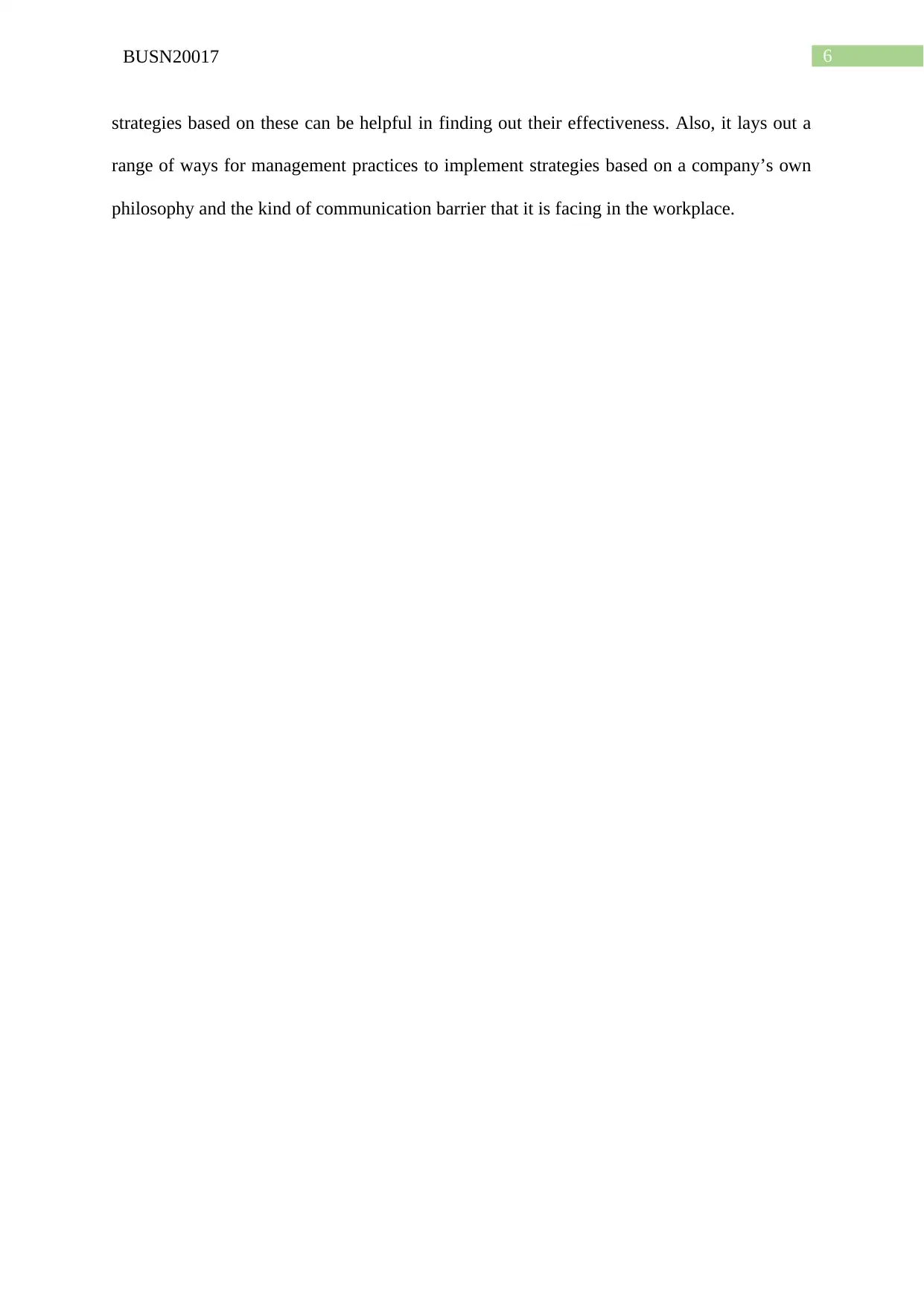
6BUSN20017
strategies based on these can be helpful in finding out their effectiveness. Also, it lays out a
range of ways for management practices to implement strategies based on a company’s own
philosophy and the kind of communication barrier that it is facing in the workplace.
strategies based on these can be helpful in finding out their effectiveness. Also, it lays out a
range of ways for management practices to implement strategies based on a company’s own
philosophy and the kind of communication barrier that it is facing in the workplace.
Paraphrase This Document
Need a fresh take? Get an instant paraphrase of this document with our AI Paraphraser
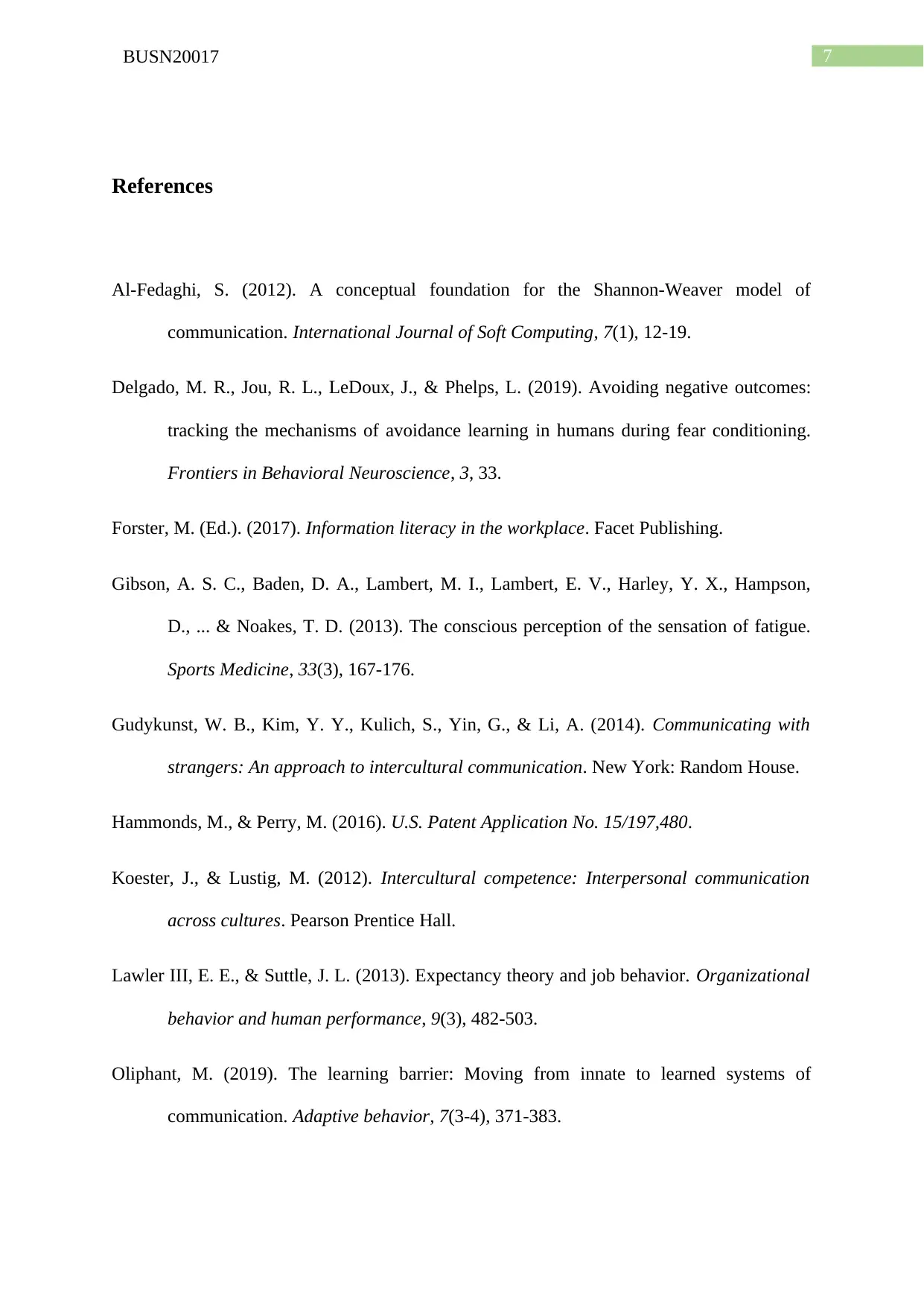
7BUSN20017
References
Al-Fedaghi, S. (2012). A conceptual foundation for the Shannon-Weaver model of
communication. International Journal of Soft Computing, 7(1), 12-19.
Delgado, M. R., Jou, R. L., LeDoux, J., & Phelps, L. (2019). Avoiding negative outcomes:
tracking the mechanisms of avoidance learning in humans during fear conditioning.
Frontiers in Behavioral Neuroscience, 3, 33.
Forster, M. (Ed.). (2017). Information literacy in the workplace. Facet Publishing.
Gibson, A. S. C., Baden, D. A., Lambert, M. I., Lambert, E. V., Harley, Y. X., Hampson,
D., ... & Noakes, T. D. (2013). The conscious perception of the sensation of fatigue.
Sports Medicine, 33(3), 167-176.
Gudykunst, W. B., Kim, Y. Y., Kulich, S., Yin, G., & Li, A. (2014). Communicating with
strangers: An approach to intercultural communication. New York: Random House.
Hammonds, M., & Perry, M. (2016). U.S. Patent Application No. 15/197,480.
Koester, J., & Lustig, M. (2012). Intercultural competence: Interpersonal communication
across cultures. Pearson Prentice Hall.
Lawler III, E. E., & Suttle, J. L. (2013). Expectancy theory and job behavior. Organizational
behavior and human performance, 9(3), 482-503.
Oliphant, M. (2019). The learning barrier: Moving from innate to learned systems of
communication. Adaptive behavior, 7(3-4), 371-383.
References
Al-Fedaghi, S. (2012). A conceptual foundation for the Shannon-Weaver model of
communication. International Journal of Soft Computing, 7(1), 12-19.
Delgado, M. R., Jou, R. L., LeDoux, J., & Phelps, L. (2019). Avoiding negative outcomes:
tracking the mechanisms of avoidance learning in humans during fear conditioning.
Frontiers in Behavioral Neuroscience, 3, 33.
Forster, M. (Ed.). (2017). Information literacy in the workplace. Facet Publishing.
Gibson, A. S. C., Baden, D. A., Lambert, M. I., Lambert, E. V., Harley, Y. X., Hampson,
D., ... & Noakes, T. D. (2013). The conscious perception of the sensation of fatigue.
Sports Medicine, 33(3), 167-176.
Gudykunst, W. B., Kim, Y. Y., Kulich, S., Yin, G., & Li, A. (2014). Communicating with
strangers: An approach to intercultural communication. New York: Random House.
Hammonds, M., & Perry, M. (2016). U.S. Patent Application No. 15/197,480.
Koester, J., & Lustig, M. (2012). Intercultural competence: Interpersonal communication
across cultures. Pearson Prentice Hall.
Lawler III, E. E., & Suttle, J. L. (2013). Expectancy theory and job behavior. Organizational
behavior and human performance, 9(3), 482-503.
Oliphant, M. (2019). The learning barrier: Moving from innate to learned systems of
communication. Adaptive behavior, 7(3-4), 371-383.

8BUSN20017
Scrima, F. (2018). The psychometric properties of the workplace attachment style
questionnaire. Current Psychology, 1-8.
Scrima, F. (2018). The psychometric properties of the workplace attachment style
questionnaire. Current Psychology, 1-8.
⊘ This is a preview!⊘
Do you want full access?
Subscribe today to unlock all pages.

Trusted by 1+ million students worldwide
1 out of 9
Related Documents
Your All-in-One AI-Powered Toolkit for Academic Success.
+13062052269
info@desklib.com
Available 24*7 on WhatsApp / Email
![[object Object]](/_next/static/media/star-bottom.7253800d.svg)
Unlock your academic potential
Copyright © 2020–2025 A2Z Services. All Rights Reserved. Developed and managed by ZUCOL.





